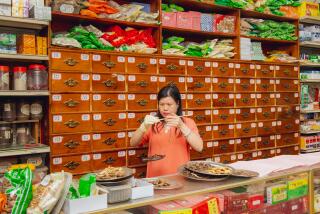Trip Can Go Up in Smoke for Certain Travelers in Southern China
- Share via
DALI, China — Vacations simply go to pot for many visitors to this pretty, mountain-backed city in southern China. And that’s just how they like it.
“It’s a forest of gold,” an Australian backpacker named Tim said at the sight of marijuana growing by the road in bushes taller than most professional basketball players.
Lured by the prospect of plentiful marijuana, travelers have flocked to Dali for years to smoke, brew and even pop the seeds of the weed one guidebook wryly describes as the local “herbal alternative . . . to cheap Chinese beer.”
About 5,000 acres by official estimates--and almost certainly more--flourish in the wild and in cultivation throughout China’s Yunnan province, making the area a marijuana mecca where users light up openly in cafes at night.
Until now, authorities have taken little notice, too busy in their fight against such harder substances as heroin and opium here on the edge of Southeast Asia’s notorious narcotics-laden “Golden Triangle.”
However, potheads beware: Yunnan officials vowed last summer to eliminate marijuana in their sprawling, mountainous province by 2000.
The pledge elicits derisive snorts from cannabis aficionados who can spot the distinctive five-pronged, serrated leaves throughout the province, from within the maze of towering limestone pillars that form Yunnan’s famed Stone Forest tourist attraction to inside the courtyard of a popular cafe in the center of Dali, about 900 miles west of Hong Kong.
“There’s not a lot you can do,” said Tim, the 18-year-old backpacker and college student from Sydney who asked that his last name not be used. “It’s kind of like trying to eradicate eucalyptus in Australia.”
The government’s new zero-tolerance policy is likely to run up against resistance from the farmers--mostly poor members of the Bai minority group--who turn marijuana into linen for their ethnic dress, infuse it in curative tonics and hawk it furtively on the streets to cash-carrying tourists.
Indeed, the drug is an active piece of the economy in Dali, a lakeside city that was the capital of an independent kingdom from the 8th to 13th centuries. Large stalks of marijuana grow right outside the cobblestoned city’s ancient north gate. Sidewalk vendors who have little luck pushing handicrafts have no trouble selling marijuana, beckoning visitors from behind hanging batik displays and fishing out little plastic bags for tourists to inspect and haggle over.
“It still smells fresh,” one woman whispered to a potential customer, pinching a packet of dried weed hidden in a sack of silver bracelets, rings and other baubles. Her asking price: $20 for about an ounce, which dropped to $5 after a few minutes of bargaining.
Trafficking in cannabis appears to be a relatively recent phenomenon, springing up in the dozen years since a visitor reported that the people of Dali “have not yet taken to selling bags” of marijuana--or da ma in Chinese, which can be translated to mean “big numbness.”
Instead, Yunnan’s trade in illegal drugs historically has revolved around such narcotics as opium and heroin. At the end of the 19th century, one writer noted that the opium poppies around Dali were taller than anywhere else on Earth, the flowers high enough to stare into the eyes of adult men.
At the time the Communists took power in 1949, according to the Yunnan government, one-third of arable land in Yunnan reportedly was devoted to narcotic-producing plants--mostly poppies--and 15% of the population was hooked on opium.
Drug addiction, along with prostitution and gambling, ranked as top vices targeted by the Communist Party, which was widely successful in its campaign to purge China of banned substances.
But the worldwide increase in drug use in the 1980s, coupled with Yunnan’s location near the Golden Triangle countries of Myanmar, Thailand and Laos, sent authorities scrambling to contain a scourge that they thought had gone away. From 1990 to 1997, Yunnan police confiscated about 30 tons of drugs, mainly heroin, smuggled in from the Golden Triangle en route to the West. This year, authorities have confiscated 4.2 tons of illegal drugs.
Yunnan officials’ focus on hard drugs from the Golden Triangle has allowed the marijuana in their own backyard to slip through the cracks. Efforts to get rid of the weed and help planters produce other crops account for only 3% of the province’s annual anti-narcotics budget of about $12 million.
Officials downplay marijuana as a problem, insisting that their plans to wipe out the plants are only secondarily about drug prevention.
“Marijuana is mainly grown in high-altitude areas by poor minority farmers, who use it to make linen for women’s skirts,” said Zou Yanping, deputy director of the Yunnan narcotics control bureau. “It’s not an economically efficient crop. The government’s efforts to replace it are to help boost the local economy and help these farmers escape the shadow of poverty. The second reason is to prevent abuse.”
Dong Jialu, an advisor to the bureau, added that the marijuana grown by farmers is different from the kind smoked by users, with too low a concentration of the active ingredient tetrahydrocannabinol, or THC, to induce any real high.
But don’t tell that to the backpackers in Dali, who pass around locally bought reefers in earthy, mellow restaurants that spin tunes by Bob Dylan and Bob Marley.
Tim, the Australian visitor, and his traveling mate, Tom, made a detour on their vacation to sample Dali’s marijuana and described it as fairly good quality.
“We actually went looking [for marijuana plants] up in the mountains and didn’t find a damn thing,” Tim said. “Then we biked back, and there they were, on the side of the road.”
Contrary to official declarations that locals are ignorant of marijuana’s more controversial aspects, two local Chinese joined the Australians one evening, wielding a large pipe and putting it to use. In all, authorities say Yunnan has 40,000 drug addicts, although the figure primarily involves heroin and opium users.
The provincial government hopes to persuade marijuana growers to turn to crops such as rice, coffee and chestnuts, as it has in cooperative efforts with neighboring countries to reduce the number of poppy plantations.
But harder to target will be villagers such as a 56-year-old farmer surnamed Yan, who does not plant cannabis in bulk but keeps a stalk outside his door. Like many fellow peasant farmers, Yan thinks of marijuana in medicinal terms. Villagers brew the leaves into a tonic whenever a nasty cough strikes, or eat baked marijuana seeds, which sell at street stalls for about 50 cents a pound, next to snacks such as dried seeds from watermelons and pumpkins.
“It helps relieve coughs. It’s good for your lungs,” Yan said. “Everyone has one or two plants in their courtyard. I have one, a big one that’s grown really well.”
Yan’s consumption, however, does not extend to inhaling--an activity he has only known one person to do.
“Several years ago,” Yan recalled, “a guy from Hong Kong asked to buy some from me so he could smoke it, but I said, ‘No, you can just pick a bunch yourself.’ ” The visitor promptly did. “He said it had a very fresh flavor.”
More to Read
Sign up for The Wild
We’ll help you find the best places to hike, bike and run, as well as the perfect silent spots for meditation and yoga.
You may occasionally receive promotional content from the Los Angeles Times.







